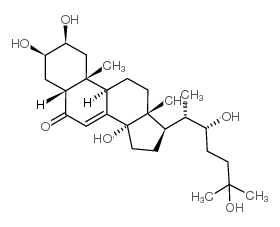ecdysone

ecdysone structure
|
Common Name | ecdysone | ||
|---|---|---|---|---|
| CAS Number | 3604-87-3 | Molecular Weight | 464.63500 | |
| Density | 1.22g/cm3 | Boiling Point | 632ºC at 760mmHg | |
| Molecular Formula | C27H44O6 | Melting Point | 242°C | |
| MSDS | Chinese USA | Flash Point | 350ºC | |
|
A crayfish molar tooth protein with putative mineralized exoskeletal chitinous matrix properties.
J. Exp. Biol. 218 , 3487-98, (2015) Some crustaceans possess exoskeletons that are reinforced with calcium carbonate. In the crayfish Cherax quadricarinatus, the molar tooth, which is part of the mandibular exoskeleton, contains an unusual crystalline enamel-like apatite layer. As this layer re... |
|
|
The silkworm glutathione S-transferase gene noppera-bo is required for ecdysteroid biosynthesis and larval development.
Insect Biochem. Mol. Biol. 61 , 1-7, (2015) Insect molting and metamorphosis are tightly controlled by ecdysteroids, which are important steroid hormones that are synthesized from dietary sterols in the prothoracic gland. One of the ecdysteroidogenic genes in the fruit fly Drosophila melanogaster is no... |
|
|
Genome-wide promoter binding profiling of protein phosphatase-1 and its major nuclear targeting subunits.
Nucleic Acids Res. 43 , 5771-84, (2015) Protein phosphatase-1 (PP1) is a key regulator of transcription and is targeted to promoter regions via associated proteins. However, the chromatin binding sites of PP1 have never been studied in a systematic and genome-wide manner. Methylation-based DamID pr... |
|
|
Transcriptional control of steroid biosynthesis genes in the Drosophila prothoracic gland by ventral veins lacking and knirps.
PLoS Genet. 10(6) , e1004343, (2014) Specialized endocrine cells produce and release steroid hormones that govern development, metabolism and reproduction. In order to synthesize steroids, all the genes in the biosynthetic pathway must be coordinately turned on in steroidogenic cells. In Drosoph... |
|
|
Negative regulation of juvenile hormone analog for ecdysteroidogenic enzymes.
J. Insect Physiol. 80 , 42-7, (2015) Disruption of the appropriate balance between juvenile hormone (JH) and ecdysteroids causes abnormal insect development. The application of a JH analog (JHA) during the early days of the final (fifth) instar induces dauer larvae with low ecdysteroid titers in... |
|
|
A novel chitin binding crayfish molar tooth protein with elasticity properties.
PLoS ONE 10 , e0127871, (2015) The molar tooth of the crayfish Cherax quadricarinatus is part of the mandible, and is covered by a layer of apatite (calcium phosphate). This tooth sheds and is regenerated during each molting cycle together with the rest of the exoskeleton. We discovered th... |
|
|
Identification, characterization, and crystal structure of an aldo-keto reductase (AKR2E4) from the silkworm Bombyx mori.
Arch. Biochem. Biophys. 538(2) , 156-63, (2013) A new member of the aldo-keto reductase (AKR) superfamily with 3-dehydroecdysone reductase activity was found in the silkworm Bombyx mori upon induction by the insecticide diazinon. The amino acid sequence showed that this enzyme belongs to the AKR2 family, a... |
|
|
HPV-E7 delivered by engineered exosomes elicits a protective CD8⁺ T cell-mediated immune response.
Viruses 7(3) , 1079-99, (2015) We developed an innovative strategy to induce a cytotoxic T cell (CTL) immune response against protein antigens of choice. It relies on the production of exosomes, i.e., nanovesicles spontaneously released by all cell types. We engineered the upload of huge a... |
|
|
Chromatin signatures at Notch-regulated enhancers reveal large-scale changes in H3K56ac upon activation.
EMBO J. 34 , 1889-904, (2015) The conserved Notch pathway functions in diverse developmental and disease-related processes, requiring mechanisms to ensure appropriate target selection and gene activation in each context. To investigate the influence of chromatin organisation and dynamics ... |
|
|
Hormonal regulation of the death commitment in programmed cell death of the silkworm anterior silk glands.
J. Insect Physiol. 58(12) , 1575-81, (2012) During larval-pupal transformation, the anterior silk glands (ASGs) of the silkworm Bombyx mori undergo programmed cell death (PCD) triggered by 20-hydroxyecdysone (20E). Under standard in vitro culture conditions (0.3 ml of medium with 1 M 20E), ASGs of the ... |